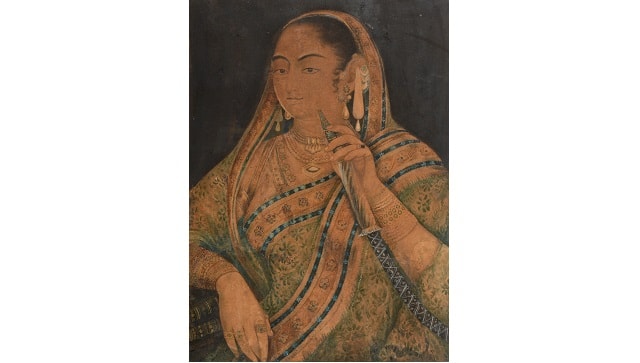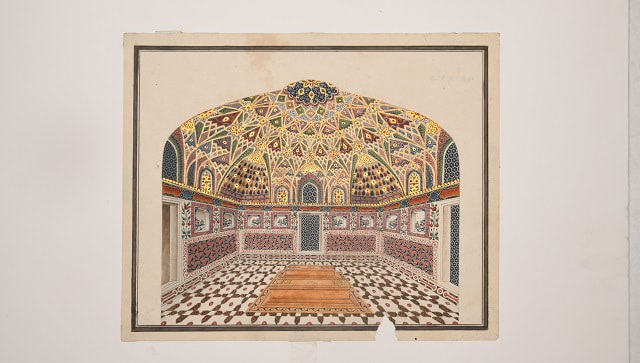A new exhibition, Company Painting: Visual Memoirs of Nineteenth-Century India at the National Museum, Delhi, captures the charm and chutzpah of painting under the East Indian Company. Company painting (Kampani Kalam in Hindi) is a term for a hybrid Indo-European style of paintings made in India by Indian artists, many of whom worked for European patrons in the
British East India Company in the 18th and 19th centuries. The style blended traditional elements of existing Indian styles (from Rajput and
Mughal painting to Tanjore art) with Western painting techniques. Most paintings were small, reflecting the Indian
miniature tradition prevalent at the time. The exhibition brings forth some of the finest collections of nineteenth-century Indian painting from five prestigious museums: the National Museum, New Delhi; National Gallery of Modern Art, New Delhi; Archaeological Survey of India, New Delhi; Victoria Memorial, Kolkata; and Botanical Survey of India, Kolkata. [caption id=“attachment_10733801” align=“alignnone” width=“640”] Qudisa Bagh Palace - Early nineteenth-century | Archaeological Survey of India, New Delhi[/caption] The exhibition attests to the diversity of nineteenth-century India and honours the many artists (mostly unknown) who have created lasting pieces of art which showcase the architecture, art, people, court scenes and artistic traditions of the time. Dr Savita Kumari, the curator of the show calls it an invaluable collection and adds, “For the first time, six premium Institutions of the country came together to bring forth the fine specimens of Company painting in the public domain. So far, the collection of the Botanical Survey of India was studied for its scientific value. Its aesthetic merit as artworks are highlighted for the first time.” A unique show The show is broadly divided into eleven subsections ranging from Indian maharajas, aristocrats and deities to vignettes of everyday life, portraiture of women and Indian architecture. [caption id=“attachment_10733811” align=“alignnone” width=“640”]
 Nur Jehan smoking a Huqqa - nineteenth century | National Gallery of Modern Art, New Delhi[/caption] Of these, some works are showcased for the first time. Limited but significant zoological studies commissioned by John Fleming from the Victoria Memorial collection adds variety to the exhibition. The exhibit also gives a sneak peek into the Delhi style of painting, particularly those of architecture, and some fine works from an album of thirty-two prints related to the event of Kabul Insurrection of 1841–42 during the First Anglo-Afghan War comprising portraits of the British prisoners, prison scenes and landscape drawings of the caves of Bamiyan from the Delhi Circle collection of the Archaeological Survey of India.
Nur Jehan smoking a Huqqa - nineteenth century | National Gallery of Modern Art, New Delhi[/caption] Of these, some works are showcased for the first time. Limited but significant zoological studies commissioned by John Fleming from the Victoria Memorial collection adds variety to the exhibition. The exhibit also gives a sneak peek into the Delhi style of painting, particularly those of architecture, and some fine works from an album of thirty-two prints related to the event of Kabul Insurrection of 1841–42 during the First Anglo-Afghan War comprising portraits of the British prisoners, prison scenes and landscape drawings of the caves of Bamiyan from the Delhi Circle collection of the Archaeological Survey of India.
Company Paintings underscore synergies between diverse artistic practices in nineteenth-century India.
It narrates the story of the decentralization of patronage, from the post Aurangzeb Mughals to the rising power centres of Murshidabad, Faizabad, Lucknow and Rajputana and then, finally the British. [caption id=“attachment_10733841” align=“alignnone” width=“641”] Late Eighteenth century to Early nineteenth century - Botanical
Survey of India[/caption] In terms of style, we see a transition from stylization to realism in the depiction of various forms. The transfer of power and resources from Indian rulers to the East India Company, influenced the nature of patronage. Substantial patronage came from Officials of the Company and other European traders, professionals, and travellers. Kumari explains, “Most of the artists producing Company Paintings were traditionally trained miniature painting artists and possessed skills to create fine artworks. Indian artists had to modify their techniques to cater to the taste of new patrons.” [caption id=“attachment_10733891” align=“alignnone” width=“640”] Maharaja Ranjit Singh with his Wazir, Dhian Singh Dogra - Mid nineteenth
century - National Museum, Delhi[/caption] European traveller artists flooded the Indian art scene from the mid-eighteenth century and introduced new vocabulary to Indian artistic traditions. Indian artists got a chance to study their work and learn the requirements of new patrons from their work. For example, Governor-General Warren Hastings provided patronage to British artists William Hodges and Tilly Kettle and the Bengal artist Sita Ram. In the exhibition, one notices an exemplary representation of Qudsia Bagh Palace, which is a copy of the work of the British artists Thomas and William Daniell. European patrons also made available to the Indian artists’ a wide range of European prints. Indian artists, trained for generations, quickly picked up realism, linear perspective, and chiaroscuro seen in European works. “What’s important to notice is that they never lost touch with their own tradition and were beautifully amalgamated with the new,” notes Kumari.
A portmanteau of subjects The collection gives us a rare glimpse of India that existed in the times of East India Company and the subsequent British Raj. The collection is diverse, and eclectic and touches upon all aspects of life, society and culture. The Indian rulers, in their flamboyant costumes, jewellery, and paraphernalia, are shown both in political and private visual contexts. A cross-section of women from different classes and backgrounds can be seen in the company painting, which moves away from the idealized visual conventions of the miniature painting. These works provide critical historical sources that facilitate our understanding of the diversity of regional and ethnic communities of India, also giving a glimpse into the material culture of the time. Kumari says that the works offer insight into the various professional and daily lives of the people. “We know about the grand processions and festivals that celebrated Indian gods and deities at that time. We also get information on the life of the Europeans in India.” [caption id=“attachment_10733831” align=“alignnone” width=“640”] Cervus Axis - Early nineteenth Century | Victoria Memorial Hall, Kolkata[/caption] Different yet similar The collection shows how different regions in India had their own significant styles. For example, Tanjore’s portraits depict strong characterisation compared to those of Punjab. Artistic outcomes also depended on patron’s political allegiance, interests, and beliefs. Company paintings are also different from those produced in Europe around the same time, where Neoclassicism, Romanticism, and Realism dominated the art scene. It was because one of the agendas behind the patronage of Company Painting was to document the various aspects of India to strengthen Company’s control over the land. The canvasses also departed from the then existing sensibilities. Instead of preparing the handmade paper, artists were now working on imported machine-made paper. Mica, ivory, and glass were other materials on which these paintings were made. Watercolours were preferred for their delicate tones and bright Indian colour palette gave way to the subdued colour palette preferred by the Europeans.
The significance of the collection These works tell us about the various aspects of the culturally vivid and diverse period of nineteenth-century India. They bring together a wide range of subjects depicted in the Company paintings to rekindle the dialogue on the Company-style paintings and celebrate Indianness in the 75th year of India’s independence. Kumari says, “At present, all over the world, there is a substantial focus on this style of painting. Yet, so far, Indian collections, lying in the premium public Institution of India, remained unseen. The exhibition attempts to span this gap.” In 2022, these paintings need to be viewed in a different light. Though produced as a part of the colonial project, today, they give us glimpses of our rich cultural tradition and diversity. [caption id=“attachment_10733881” align=“alignnone” width=“640”] Chini Ka Rauza - 1810 -National Museum, Delhi[/caption] The showcase the spirit of Indian culture of amalgamation and co-existence as well as the zeal to survive in the face of hardship. Kumari adds, “The artists were losing employment due to the collapse of the traditional patronage structure. They did not give up, instead addressed to the changing needs of the time.” The exhibition blurs the boundaries between arts and sciences. There are many things to learn here; from birds to landscapes and aristocracy, this collection gives us a thorough overview of the time gone by. Encompassing a wide range of subjects, this unique exhibition, is a window into the past and brings its rich vocabulary to life. Read all the
Latest News ,
Trending News ,
Cricket News ,
Bollywood News ,
India News and
Entertainment News here. Follow us on
Facebook,
Twitter and
Instagram.


)
)
)
)
)
)
)
)
)



